Wyoming is home to roughly 800 of the 4,000 native bee species found in North America. Collectively, these insects are considered the state’s most important pollinators.
Unfortunately, scientific studies suggest that some populations of these essential insects are declining at alarming rates, both in Wyoming and worldwide.
So, what’s going on? And why should you care about the fate of these plucky little pollinators?
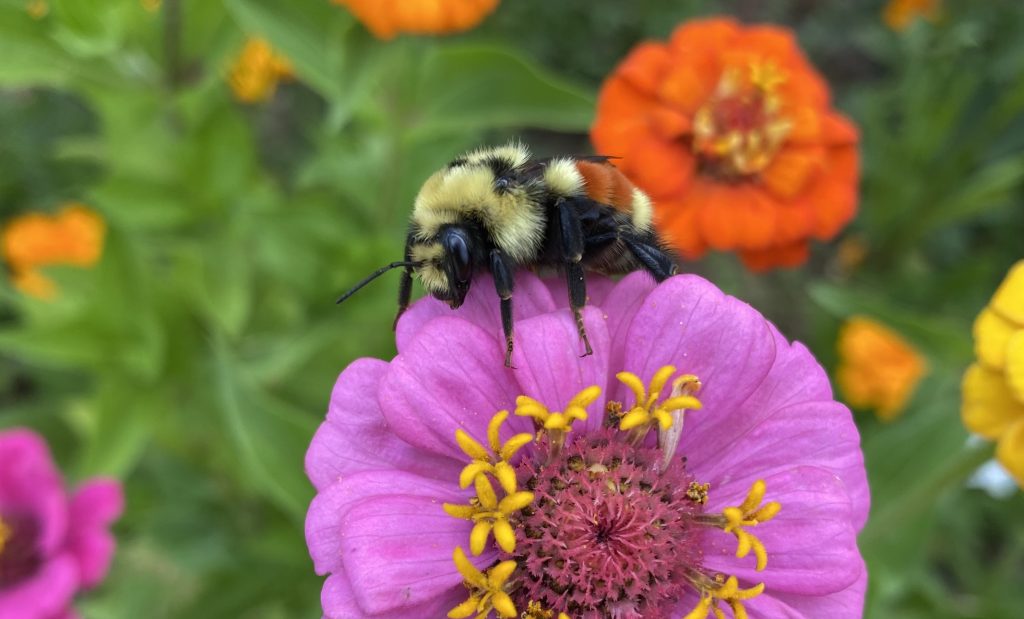
Table of Contents
Bee benefits
According to the USDA Natural Resources Conservation Service (NRCS), 75% of the world’s flowering plants depend on animal pollinators, such as honey bees and bumble bees, to reproduce.
Pollination occurs as bees move pollen within or between flowers while foraging. This action, seemingly secondary to the forager’s mission, is vital to the survival of plants, animals, and humans.
Scientists have recognized the importance of pollination for decades. An oft-cited USDA report, originally published in 1976, asserts that “it appears that perhaps one-third of our total diet is dependent, directly or indirectly, upon insect-pollinated plants.”
In addition to pollinating key crops, bees help support other beneficial insects. “It’s not all about beneficial pollination of our broadleaf crops—it’s also about maintaining health and ecosystem processes,” explains UW Extension entomologist Scott Schell. “If we lose pollinators that help with the production of seeds of non-crop plants out in nature, we risk losing the portion of insect fauna that helps control pests.”
Pollinators in peril
In the scientific world, the common name “bee” refers to a member of the Apidae family from the order Hymenoptera. Wyoming’s native bees include various bumble bee species and solitary ground-dwelling species such as sweat bees, mining bees, and long-horned bees. Common commercially managed bees in Wyoming include alfalfa leaf cutter bees and honey bees, both of which nest in man-made structures.
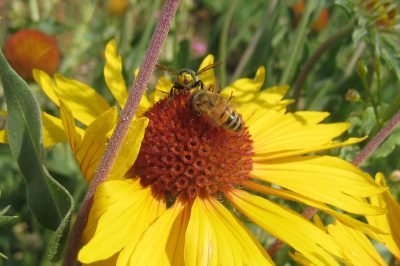
In the past 15 years, studies around the world have documented significant declines in populations of several bee species. In the U.S., honey bees and the native western bumble bee (Bombus occidentalis) have experienced well-documented declines. However, population trend data for the vast majority of bee species is lacking.
Compared to their domesticated counterparts, wild bee populations tend to be much more difficult to track, which makes it challenging to quantify decline.
“We definitely need to have baseline data—studies that are looking at whether a population is rare or in decline,” Schell notes. “There’s a difference between the two. If it’s marginal habitat, we might think they’re rare, but maybe it’s just because that’s not good habitat.”
This knowledge gap provides an opportunity for citizen scientists to contribute to data collection, he adds. In Wyoming, the annual BioBlitz event is one way to help document bee sightings. People can also contribute to baseline data on insect pollinators all season long, from anywhere in the state, via the iNaturalist mobile app.
Efforts like the international Discover Life program and Iowa State University’s BugGuide initiative also offer opportunities for citizen scientists to help catalog insect populations.
Are pesticides the problem?
Scientists have identified habitat loss, climate change, disease, parasites, and pesticide use as factors that can contribute to bee decline.
Products like neonicotinoids—insecticides made of synthetic nicotine—can harm bee populations, especially if application is ill timed or label specifications are not followed.
“Neonicotinoids are systemic, so the product is taken up by the roots, translocated by the plant, and the plant is protected from chewing or sucking insects,” explains Jeff Edwards, UW Extension pesticide safety education program coordinator. “Normally these products shouldn’t affect bees, but if the plant happens to have that product in it and then blooms, there’s studies that show these insecticides are in pollen and could impact them.”
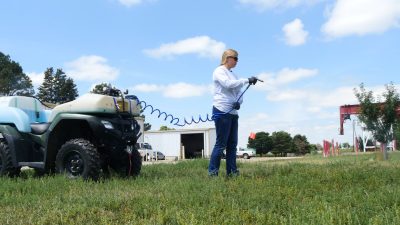
In particular, some studies have found that frequent exposure to this kind of product can impact honey bee behavior—they might get lost and not be able to find their way back to their hive, for instance.
If you choose to use pesticides, the key is to read the label and apply them responsibly. “There are so many types of bees and so many types of insecticides that it would be really hard to say, ‘Don’t use this product because it kills bees,’” says Edwards.
Even if the plants you’re trying to protect are in bloom, it’s possible to minimize risk by applying the product while bees are not active. “Bees in general are daytime active, so if you have an infestation and your plant is blooming, you can apply at dusk,” Edwards explains. “The product will work on the pest overnight, and the next day it should be fine for bees to go back into that area.”
In Wyoming, beekeepers are required to register their hives with the Wyoming Department of Agriculture. In turn, both private and commercial pesticide applicators are responsible for notifying beekeepers in areas where they may apply pesticides so that beekeepers can move their hives or implement other protective measures.
Meddlesome mites and parasites
In Edwards’ experience, Wyoming beekeepers are more likely to run into problems with mites, parasites, and viral diseases than insecticide-related issues.
The varroa mite, for instance, is a parasite found in honey bee colonies across the country. In addition to feeding on developing and adult bees, these intruders also transmit viruses. In fact, they’re the vector for most of the viral diseases affecting honey bees.
“Managing those mite populations is a knife’s edge balance because it’s controlling an arthropod that’s hurting an arthropod,” says Edwards. “Honey bee producers still have to treat for those mites and there’s going to be insecticidal exposure through that. But if they don’t control the mites, bee populations will be destroyed.”
Honey bee populations managed for commercial purposes are often plagued by chalkbrood disease and foulbrood disease. Even worse, these diseases can “spill over” and spread to wild bee populations.
A 2008 study at the University of Toronto found that domesticated bumble bees used in greenhouses could potentially transmit highly contagious diseases to wild bees through interactions on foraging trips. Using mathematical modeling, the researchers determined that pathogen “spillover” from commercial bees could potentially cause epidemics in wild bee populations nearby.
Worrisome weather
Unfortunately, disease spillover isn’t the only environmental factor that may influence bee populations. Climate scientists predict that extreme weather events will become more frequent going forward; inevitably these changes will affect bees and the flowering plants they depend on for sustenance.
Late spring blizzards or longer drought periods, for instance, could significantly impact both bees and their food sources, says Schell.
While native Wyoming bumble bees like Bombus huntii, found in the Snowy Range, are well equipped to weather cold temperatures, it’s unclear how they may respond to increased heat stress. UW researchers are currently investigating this question, using RFID trackers to determine how heat stress affects foraging behavior.
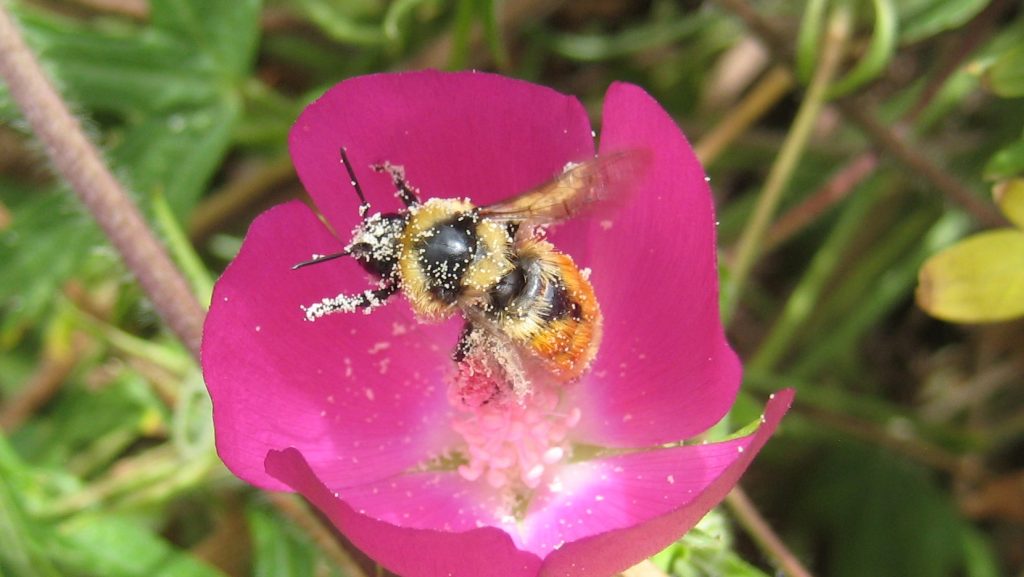
Habitat loss
Even before climate change was recognized as a threat to suitable habitat, changing land use was already affecting insect pollinators. As early as 1954, researchers observed that, “With a planting of many acres, there may not be enough insects such as honey bees to visit the millions of flowers normally present. Even native pollinating insects may be somewhat scarce because the very activity of preparing and cultivating such a large area of land may have destroyed some of their nesting places.”
While this issue is currently more prevalent in the Midwest, “Wyoming has had some of the same economic drivers of farms needing to get bigger to survive,” Schell comments. “Bigger farms that buy more land and use bigger machinery tend to have less border areas that can be a source of pollinator habitat.”
Fence rows, barrow ditches, and grasslands provide better habitat than cultivated fields, especially for native bees that nest in the ground. Compared to the rest of the country, Wyoming offers plenty of open space and vegetation suitable for bees to make their homes. Still, valuable habitat vanishes when a field is paved or converted to a shopping center bordered by just a handful of shrubs.
Help protect pollinators
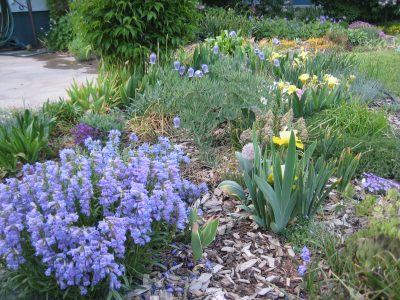
If you’re concerned about the plight of Wyoming bees, providing quality food and habitat is a good place to start. “Without flowering plants, pollinators can’t survive,” says Schell. “One of the major ways to promote pollinators is developing habitat in your yard or other landscapes you have control of.”
For more information on Wyoming pollinators and how to help them, visit https://bit.ly/wyo-pollinators to download the UW Extension publication “Promoting Pollinators on Your Place: A Wyoming Guide.” For advice on creating a thriving pollinator habitat, check out UW Extension educator Amy Smith’s article “Consider Creating a Pollinator Habitat” at https://bit.ly/create-pollinator-habitat.
Additional resources can be found on the Barnyards & Backyards site at https://bit.ly/backyard-resources.
For questions about insect pollinators in Wyoming, contact Schell at sschell@uwyo.edu or (307) 766-2508. For questions about pesticide use in Wyoming, contact Edwards at jedward4@uwyo.edu or (307) 837-2956.




